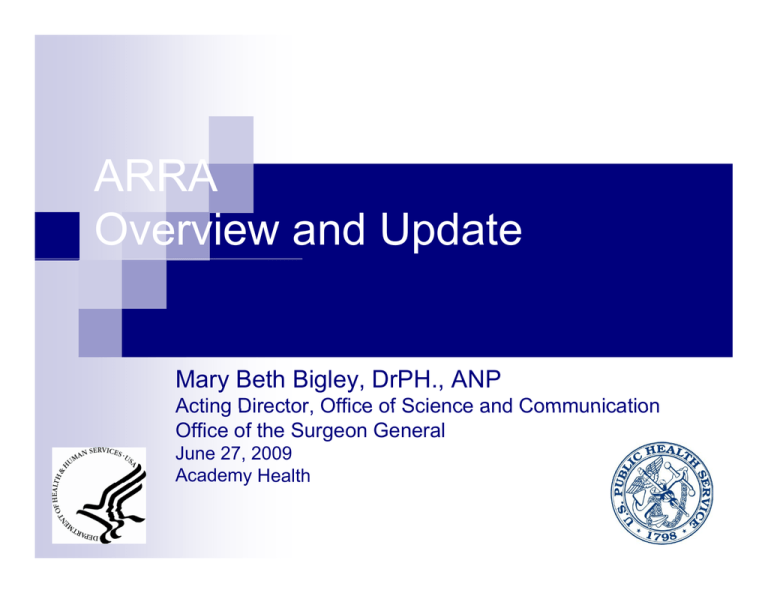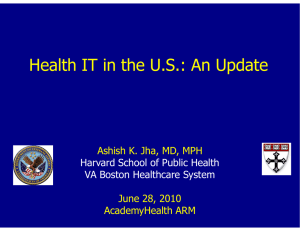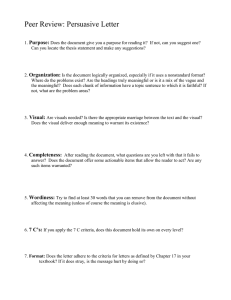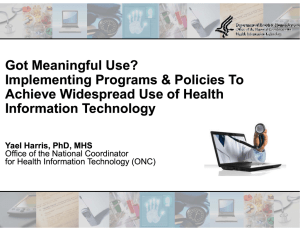ARRA Overview and Update Mary Beth Bigley, DrPH., ANP
advertisement

ARRA Overview and Update Mary Beth Bigley, DrPH., ANP Acting Director Director, Office of Science and Communication Office of the Surgeon General June 27, 2009 Academyy Health 1 American Recovery and Reinvestment Act of 2009 (ARRA) The American Recovery and Reinvestment Act of 2009 (ARRA) Signed into law by President Obama on February 17th 17th, 2009 2009. It is an unprecedented effort to jumpstart our economy, create or p a down payment p y on addressing g save millions of jjobs,, and put long-neglected challenges so our country can thrive in the 21st century. The Act is an extraordinary response to a crisis unlike any since the Great Depression, and includes measures to gy modernize our nation's infrastructure,, enhance energy independence, expand educational opportunities, preserve and improve affordable health care, provide tax relief, and protect those in greatest need. HHS Overview of the Recovery Act: http://www.hhs.gov/recovery 2 ARRA HITECH American Recovery and Reinvestment Act off 2009 (Recovery (R A Act) t) iis iintended t d d tto improve the nation’s health care through health information technology (HIT) by promoting the meaningful use of electronic health records (EHR) (EHR). Health Information Technology for E Economic i and d Clinical Cli i l Health H lth Act A t or the th HITECH Act. 3 U S EHR Adoption U.S. 4 HITECH G Goals l Improve the efficiency and quality of health care through EHR Is a step in health care reform Utilization of an EHR for each person p in United States by 2014* Outreach g goal is adoption p of EHRs by y 100% of providers by 2014. American Recovery and Reinvestment Act of 2009: Title XIII; Part I, Subtitle A, Sec. 3001 (c)(3)(A)(ii) 5 ONC Role Development of a nationwide HIT infrastructure that allows for electronic use and exchange of information that: Ensures secure and protected patient health information Improves health care quality and reduces health care costs Improves coordination of care and information among hospitals, labs, physicians, etc. Improves public health activities and facilitates early identification/rapid response to public health emergencies Facilitates health and clinical research Promotes early detection, prevention, and management of chronic diseases Improves efforts to reduce health disparities 6 HIT Committee C itt Structure St t HIT Policy y Committee Meaningful Use Work Group Certification/Adoption p Work Group p Health Information Exchange Work Group HIT Standards Committee Clinical Operations Work Group Quality Work Group Privacy/Security Work Group 7 Recommendations from the Meaningful Use Workgroup to the Health IT Policy Committee on June 16, 2009 The American Recovery and Reinvestment Act authorizes the Centers for Medicare & Medicaid Services (CMS) to provide a reimbursement incentive for physician and hospital providers who are successful in becoming “meaningful users” of an electronic health record (EHR). These incentive payments begin in 2011 and gradually phase down. Starting in 2015, providers are expected to have adopted and be actively utilizing an EHR in compliance with the “meaningful use” definition or they will be subject to financial penalties under Medicare. 8 M Meaningful i f l EHR U Users Demonstrate meaningful use of a certified EHR the electronic exchange of health information to improve p the quality q y of health care reporting g on clinical quality y and other measures using certified EHR technology 9 M Meaningful i f lU Use C Context t t Actions that providers perform: Write prescriptions electronically Document allergies Manage a population of diabetics Report quality measures Actions should lead to improvements in the safety, safety quality and efficiency of care Will evolve over time To achieve the full range of desired care outcomes, meaningful use should be accompanied by healthcare reform 10 Achieving Meaningful Use Requires Removal of Barriers Poor EHR fi P financial i lb business i case for the provider $34B in i financial fi i l incentives i ti Poor interoperability business case of the p provider Meaningful Use definition will involve interoperability Small physician practices and hospitals don’t have the staff to implement EHRs Health Information Extension Programs to provide adoption assistance $40K to $60K/physician $2M-$11M/hospital Full payment requires meaningful use in i 2011 2011-2012 2012 ePrescribing P ibi Clinical data exchange Quality measures reporting 11 Achieving Meaningful Use Requires Removal of Barriers Adoption, meaningful use and interoperability require local governance and action $300M ffor states to d develop l and d implement interoperability and adoption plans There are not enough people to do all of the implementation work Funds will be available for health informatics educational programs Stronger privacy protections are needed Privacy laws strengthened; Federal Chief Privacy Officer Continued C ti d work k on standards t d d and EHR certification is needed The standards and certification processes will be reviewed to identify process and outcome improvements 12 Goals Short term: Rapidly develop health information exchange (HIE) capacity across states over 2-3 years to enable providers to qualify for meaningful use incentives: Mid t Mid-term: Widespread adoption of a broader set HIE services across all health care and public health stakeholders over 3-5 years Expand infrastructure (network services and organizational models) to mobilize clinical data needed for consumer engagement and health reform across all states 13 St t Status In the next several months ONC/HHS will be leveraging its committee structure and outreach activities to engage the field in this undertaking The specifics of these programs and definitions will be announced Over the next several years We have a lot of work to do 14 S b G l off HITECH Outreach Sub-Goals O t h Providers Adopt EHRs early Loan & grant programs (academic programs, state & Indian Tribe grants for provider loans) Technical support (extension centers), and Medicare/Medicaid meaningful use incentive payments Protect patient health information Consumers Build B ild H Health lth IT ttrustt and d understanding d t di iin b benefits fit off EHR EHRs tto improve their healthcare Increase personal responsibility regarding health information Establish awareness of personal health information protections Advance adoption of EHRs by providers 15 Comment Period for Meaningful Use ONC is seeking comments on the preliminary definition of “Meaningful Use,” as presented to the HIT Policy Committee on June 16, 2009 Due by 5 pm EST June 26, 2009, and should be no more than 2,000 words in length Electronic responses to the draft description of Meaningful Use are preferred and should be addressed to: MeaningfulUse@hhs.gov With t the t e subject line e “Meaningful ea g u Use Use” Written comments: Office of the National Coordinator for Health Information Technology 200 Independence p Ave, SW. Suite 729D Washington, DC 20201 16 ARRA Prevention and Wellness Fund Totall off $1,000,000,000 T $1 000 000 000 administered d i i d through h h Department of Health and Human Services CDC received $300,000,000 to carry out their i immunization i ti program $650,000,000 is provided to be used to carry out evidence-based clinical and community-based pre ention and wellness prevention ellness strategies to reduce red ce chronic disease rates $50,000,000 is provided to States to carry out activities to implement reduction strategies for healthcare-associated infections 17 Resources Medicare and Medicaid Health Information Technology: Title IV of the American Recovery and Reinvestment Act (fact sheet) http://www.omhrc.gov/assets/pdf/checked/ http://www omhrc gov/assets/pdf/checked/ 1/CMSHITECHFactSheetandFAQs.pdf http://healthit.hhs.gov/portal/server.pt htt //h lthit hh / t l/ t 18




